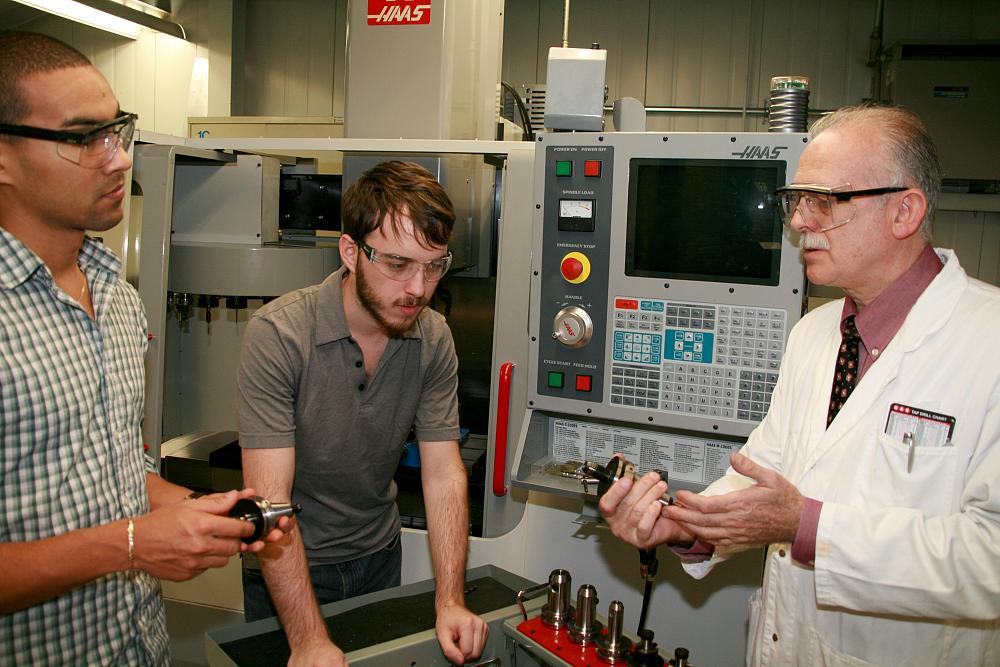- FMA
- The Fabricator
- FABTECH
- Canadian Metalworking
Training profile: Seneca College [video]
The college's cumulative 3-year industrial design course gives students a broad range of training for real world situations.
- By Nick Healey
- January 30, 2014
- Article
- Metalworking
Seneca College is spread across a number of locations in the Greater Toronto area, with 10 campuses in total.
The college has a thriving metalworking program, which is based at their Centre for Advanced Technologies at the school’s Jane campus, in the North York region of Toronto. Additionally, Seneca’s King campus, located north of Toronto in King City, acts as a test centre for the Canadian Welding Bureau, and their Faculty for Continuing education and Training (FCET) teaches the CWB program at the same location.
The Centre for Advanced Technologies has four programs on offer (see below). Two are 1-year programs, the next is a 2-year program, and then a 3-year program as well. The college offers a ‘laddered’ system with their courses where the 1-year program serves as the first year of the 2-year program, and then the 2-year program becomes the foundation of the 3-year program. This allows students to take the first year or two of the 3-year program then, continue on, or try their hand in the industry. If they choose to return, they can pick up where they left off and move smoothly through the program.
The cumulative 3-year program is an industrial design course, which seeks to give students a broad range of training they they’ll need for real world situations. Romel Cipriani is professor and program coordinator at the college and spoke to Canadian Metalworking about the program.
“(In) this program we focus on higher end technology. We’re introducing learners to white light scanning technology, reverse engineering, quality assurance, report generating, and we’re also introducing the concepts of business management. So, project management, looking after a budget, working in groups, copyright laws,” he said.
“We're keen on making sure our students are able to be moved within different roles - because that's we're finding is happening. We're trying to give them the tools that will allow them to be successful within those parameters.”
The school also works closely with area high schools to encourage participation for students looking to get involved with the trades. Cipriani’s colleague Malcolm Archer, a professor at the college, elaborated on those efforts.
“For the last 11-12 years now, we've had an arrangement with the York Catholic District School Board, where their grade 10s, 11s, and 12s come to our campus and use our CNC equipment and lab,” Archer says.
“This relationship means they can come in and take advantage of all of our beautiful equipment, we can give them resources in the form of the equipment and the expertise, and some of those students who take that particular course, do end up coming to Seneca College.”
Seneca has new technology and equipment at their disposal, such as a Sodick wire EDM, a Haas milling machine, and white light scanners. The college also works closely with The Ontario Association of Certified Engineering Technicians and Technologists (OACETT) to ensure that students can gain their C.E.T. designations after their studies.
“We’re seeing that these designations are now creeping into job description requirements,” says Cipriani. “We try our very best to try and integrate what’s happening in the future.”
Seneca’s metalworking program at a glance:
Location: Jane Campus, North York, Ontario.
Relevant Courses Offered:
-Mechanical Techniques - CNC Programming – 1 year,
-Mechanical Techniques (Tool and Die/Mould Making), – 1 year,
-Mechanical Engineering Technician (Tool Design) – 2 years,
- Mechanical Engineering Technology - Industrial Design – 3 years
Tuition: First year, $3,156. Additional cost of supplies varies depending on the program, but range between $1,500 and $1,900.
For more information on Seneca’s program, visit: www.senecac.on.ca
About the Author
subscribe now


Keep up to date with the latest news, events, and technology for all things metal from our pair of monthly magazines written specifically for Canadian manufacturers!
Start Your Free Subscription- Industry Events
Automate 2024
- May 6 - 9, 2024
- Chicago, IL
ANCA Open House
- May 7 - 8, 2024
- Wixom, MI
17th annual Joint Open House
- May 8 - 9, 2024
- Oakville and Mississauga, ON Canada
MME Saskatoon
- May 28, 2024
- Saskatoon, SK Canada
CME's Health & Safety Symposium for Manufacturers
- May 29, 2024
- Mississauga, ON Canada





















